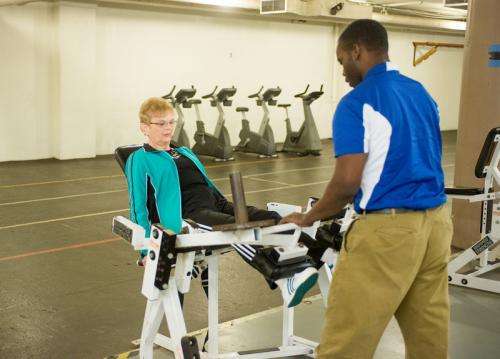Research uses lasers, resistance training to zap fibromyalgia pain

(Medical Xpress)—For years, Kay Greenlee couldn't wash the windows in her home without hurting. The Terre Haute woman suffers from fibromyalgia and allergic reactions prevented her from taking medicine to relieve pain in her legs and shoulders.
Now, thanks to a research study in Indiana State University's College of Nursing, Health, and Human Services, Greenlee is nearly pain free.
"I have gone from having a lot of pain to very minimal amount of pain in the shoulder. I have little or no pain at all in the legs," she said. "It is exciting to be able to go for several hours and be energetic and do the work that needs to be done at home and to enjoy things."
Greenlee is benefitting from months of low-powered laser therapy and resistance exercise training as part of a research project involving faculty and students from the departments of kinesiology, recreation and sport and applied medicine and rehabilitation.
"Many individuals with fibromyalgia syndrome are afraid to exercise because of the pain or their perception of how much pain they will be in the next day," said Tim Demchak, associate professor of applied medicine and rehabilitation. The low level laser helps decrease their pain and helps them feel like exercising."
Researchers believe low-level laser therapy helps patients with fibromyalgia syndrome by increasing blood flow to the painful area, contributing to the release of the amino acid beta endorphine and decreasing pain receptor activity in treated areas.
Researchers divided participants in the study into four groups. One group received laser therapy only while another group received resistance training only, a third group received laser placebo therapy and the fourth group, which included Greenlee, combined laser therapy and resistance training.
"The idea is that pain in a person with fibromyalgia is because of restriction in blood flow. Resistance training opens up more blood flow and more blood flow into the area of pain will result in less pain," said Ifeanyi Osude, who was involved in the research for more than one year and graduated from Indiana State in May with a bachelor's degree in exercise science.
"I've seen great results. Women came in with immense pain they have had for weeks or even months and after they have done the laser treatment, along with the resistance training, they came to me and said, 'Ifeanyi, I feel a lot better,'" he said.
Osude said researchers worked with participants in the study to ensure that they continue some sort of physical activity to help them keep fibromyalgia pain at bay.
"For me, this is the beginning," said Greenlee. "My goal is to find someone that will help me to continue (with therapy) so that I can be as good as I can be— to be strong and to continue to exercise."
The resistance therapy included chest presses, leg extensions, seated rowing and leg curls - all using weights of various sizes.
The 70-year-old Greenlee, a retiree from the university's Division of Business Affairs and Finance, said she "never thought about lifting weights or doing that type of exercise." But Osude and other students, along with ISU faculty members who led the research, offered "constant encouragement," she said. "The students have been very professional. It's great to be able to work with them because I feel like they are helping me, but I am also helping them."
Osude, a Crystal Lake, Ill. resident who plans a career in physical therapy, is staying at Indiana State to complete a master's degree.
"This research has provided me with an opportunity to get into the field I've always wanted to be in," he said. "Doing that as an undergraduate it looks great on a resume. It has also given me the opportunity to be able to learn how to communicate with a patient and find out what's wrong, where their area of pain is and how to go about figuring out ways to help them."
Demchak Indiana State researchers hope to complete a similar study in the future but have patients perform laser treatments at home with portable lasers. Currently, people have to go to a clinic that has a laser in order to be treated.

















